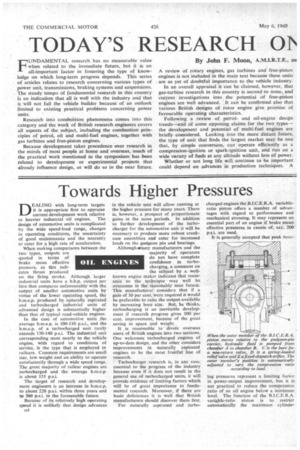TODAY'S RESEARCH Oi's 'OMORROW'S DESIGNS
Page 118

Page 119

If you've noticed an error in this article please click here to report it so we can fix it.
By John F. Moon, A.M.I.R.T.E., an A. C. Brockington, A.M.I.Mech.E. FUNDAMENTAL research has no measurable value when related to the immediate future, but it is an all-important factor in fostering the type of knowledge on which long-term progress depends. This series of articles relates to research concerning various types of power unit, transmissions, braking systems and suspensions_ The steady tempo of fundamental research in this country is an indication that all is well with the industry and that it will not fail the vehicle builder because of an outlook limited to existing practical problems concerning power units.
Research into combuStion phenomena comes into this category and the work of British research engineers covers all aspects of the subject, including the combustion principles of petrol, oil and multi-fuel engines, together with gas turbines and free-piston engines.
Because development takes precedence over research in the minds of most people at home and overseas, much of the practical work mentioned in the symposium has been related to development or experimental projects that already influence design, or will do so in the near future. A review of rotary engines, gas turbines and free-piston engines is not included in the main text because these units are as yet of doubtful importance to the vehicle industry.
In an overall appraisal it can be claimed, however, that gas-turbine research in this country is second.to none, and current investigations into the potential of free-piston engines are well advanced. It can be confirmed also that various British designs of rotor engine give promise of favourable operating characteristics.
Following a review of petroland oil-engine design trends—and of some opposing claims for the two types— the development and potential of multi-fuel engines are briefly considered. Looking into the more distant future, the type of unit that finds the largest market may be one that, by simple conversion, can operate efficiently as a compression-ignition or spark-ignition unit, and run on a wide variety of fuels at any altitude without loss of power.
Whether or not long life will continue to be important could depend on advances in production techniques. A short-life throw-away all-welded unit would, for example, be acceptable to many operators if its cost were low and installation and removal simple.
So far as transmissions are concerned, there are two distinct lines of thought in this field: the conventional all-mechanical manually operated transmission, and the more complex but often more efficient semiand fully automatic types. Each has its place in the industry and the relatively slow development of successful designs of automatic transmission is undoubtedly caused by the years of research and vast sums of money that are necessary to attain anything approaching perfection.
Braking systems form the, most important components of any road vehicle, for without good brakes no vehicle can be deemed safe under any condition. The principal brake manufacturers in Britain have extensive research and development facilities and employ the cream of fully trained technicians and engineers to further their aims.
In this field also progress can be slow, as seen by the somewhat reluctant acceptance of disc brakes which, although eminently suitable for high-speed motorcars, present certain complications when applied to heavy vehicles, which may or may not outweigh their advantages. In the meantime, the drum brake is by no means forgotten and this still forms the basis for a major rl'ortion of the research work in the braking field.
Cost is of prime importance throughout the industry and is one of the things which research and development engineers have to work against. This is particularly so with regard to braking and suspension systems. In the latter case, cost can be assessed in terms of low price or economy in operation, such as increased tyre, chassis and body life.
Air suspension is obtaining a foothold, but rubber suspension may come into its own or many applications. Because of its simplicity, however, the steel spring still retains a major part of the market and recent developments could give it a new lease of life. Hydraulic suspension systems may be round the corner, bringing with them an attendant batch of fresh problems.




































































































































































































































































